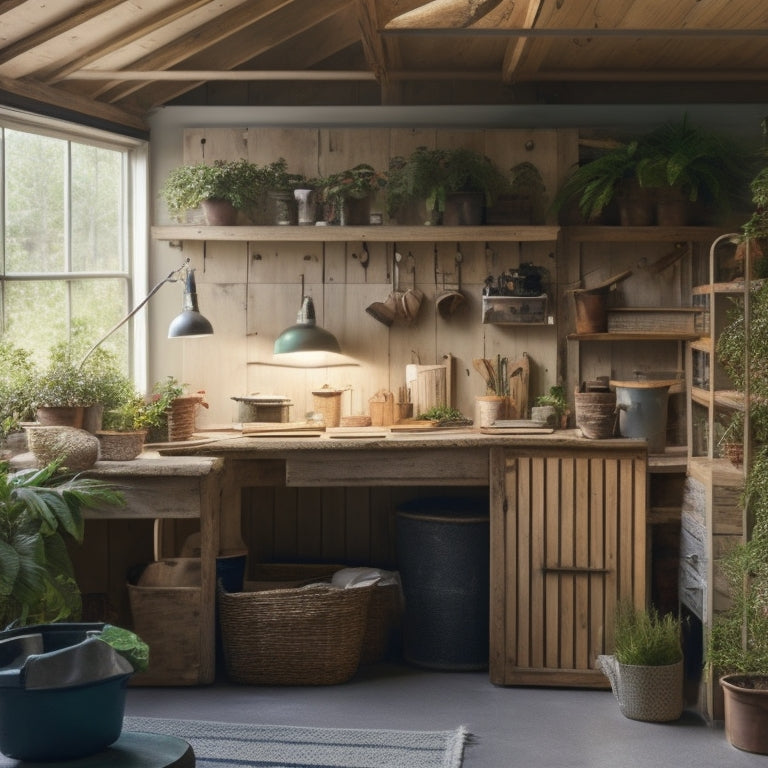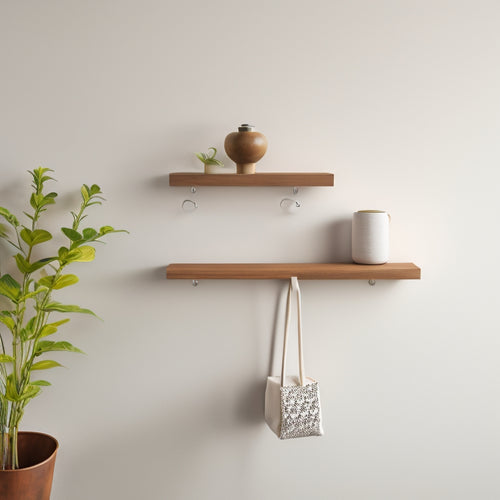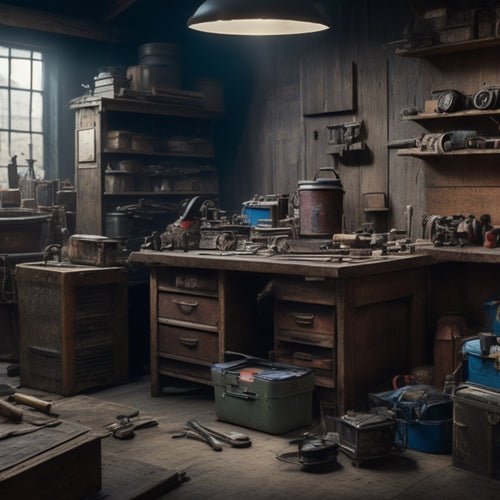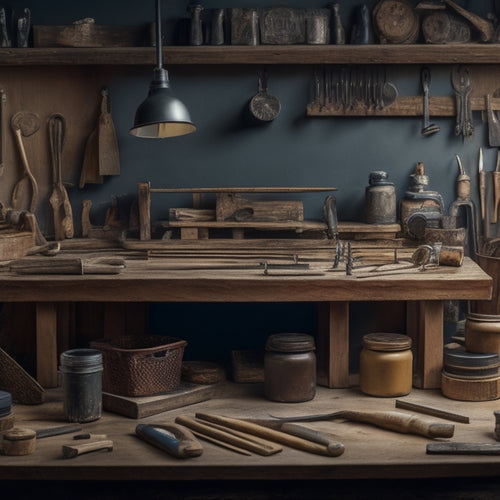
7 Simple Shed Organization Ideas for a Clutter-Free Space
Share
You can reclaim your cluttered shed by implementing a few simple organization ideas. Start by assigning a home for your tools, categorizing them into frequently used, occasionally needed, and rarely touched, and storing them accordingly. Make use of vertical storage space by installing shelf brackets and hooks for bins, baskets, and tools. Create a shelf for less-used items, and designate a zone for seasonal items. Add a workbench with built-in storage, and incorporate bins and labels to keep similar items grouped together. By tackling these tasks, you'll be well on your way to a clutter-free space that enhances your productivity and peace of mind – and there's even more to investigate to take your organization to the next level.
Key Takeaways
- Assign a home for tools by categorizing them into frequently used, occasionally needed, and rarely touched, and store them accordingly.
- Implement a pegboard system to maximize vertical space, reduce clutter, and increase productivity by hanging tools within reach.
- Utilize vertical storage space by installing shelf brackets, wall-mounted racks, and hooks to free up floor space and keep items organized.
- Create a shelf for less-used items, using durable materials and incorporating bins or baskets for smaller items to enhance organization.
- Label each storage bin with contents and category for clarity, and regularly review and reorganize bins to adapt to changing needs.
Assign a Home for Tools
Assign a Home for Tools
Most of your tools likely fall into one of three categories: frequently used, occasionally needed, or rarely touched. This categorization is essential in assigning a home for each tool.
Frequently used tools should be easily accessible, while occasionally needed tools can be stored in a convenient but slightly less accessible spot. Rarely touched tools can be stored in harder-to-reach areas or on higher shelves.
To guarantee tool accessibility, designate a specific area for each category. For example, you can install a pegboard near your workbench for frequently used tools like hammers, screwdrivers, and pliers.
Occasionally needed tools like drills, saws, and sanders can be stored in a nearby cabinet or on a shelf. Rarely touched tools like specialized equipment or seasonal items can be stored in bins or containers on higher shelves.
Utilize Vertical Storage Space
You're likely to have more tools than available floor or shelf space in your shed. This is where utilizing vertical storage space comes in. By making the most of your shed's walls and ceiling, you can free up precious floor space and keep your tools organized.
To maximize your vertical storage, consider the following:
-
Install shelf brackets to hold bins, baskets, or small tools, keeping them off the floor and out of the way.
-
Use wall-mounted racks to store items like bikes, lawn equipment, or luggage, keeping them secure and organized.
-
Hang tools like hoses, ropes, or extension cords from hooks or a peg hook board, keeping them untangled and easily accessible.
Implement a Pegboard System
You'll love the flexibility a pegboard system brings to your shed organization.
By installing a pegboard, you'll open up a world of tool storage options and pegboard design ideas that'll maximize your vertical space.
From hanging bins and baskets to hooks and reels, you'll be able to customize your pegboard to fit your specific needs and keep your tools within easy reach.
Tool Storage Options
Get a grip on your tool collection by implementing a pegboard system, a breakthrough for maximizing storage space and streamlining your workflow.
This efficient storage solution allows you to hang tools within easy reach, reducing clutter and increasing productivity.
Pegboards cater to various toolbox types, from compact units for small sheds to large systems for extensive tool collections.
When choosing a pegboard, consider the type of tools you need to store and the available space in your shed.
Some popular tool storage options include:
- Hooks for hanging items like bikes, hoses, and extension cords
- Bins and containers for storing small parts and accessories
- Slotted panels for organizing screwdrivers, wrenches, and other handheld tools
Pegboard Design Ideas
Implementing a pegboard system requires thoughtful design to confirm it meets your specific tool storage needs.
You'll want to contemplate the types of tools you have, how often you use them, and how you can maximize your space. Start by choosing a pegboard layout that suits your needs. You can opt for a standard layout or create a custom pegboard with adjustable shelving to fit your unique tools.
Next, select pegboard hooks and accessories that fit your tools, such as bins for small items or hooks for larger equipment. Contemplate using decorative pegboards or color-coded organization to add visual appeal and make it easier to find what you need.
Multifunctional boards can also be used to create seasonal displays or store items like gloves and hats. Finally, prioritize tool visibility to confirm you can quickly find what you need.
With a well-designed pegboard system, you'll be able to access your tools efficiently and safely, making your shed organization efforts a success.
Maximizing Vertical Space
About 75% of your shed's wall space remains unused, leaving ample opportunity for maximizing vertical space. By implementing a pegboard system, you can efficiently employ this space and keep your shed organized.
Start by installing shelf brackets to create additional storage for less frequently used items. Next, consider adding wall planters or hanging baskets to store small items like gloves, safety glasses, or other accessories.
-
Use magnetic strips to hang metal tools or accessories, keeping them within easy reach.
-
Install overdoor racks or wall mounted hooks for hanging items like bikes, tools, or equipment.
-
Employ ladder storage to keep ladders off the floor and out of the way, while also freeing up space for other items.
Create a Shelf for Less-Used Items
You'll likely have some items in your shed that you don't use frequently, but still need to keep. Create a shelf for these less-used items to keep them organized and out of the way.
Choose shelf materials that are durable and can hold the weight of the items you plan to store. Consider using metal or wood shelves, as they're sturdy and can withstand the elements.
When deciding on the shelf height, think about the items you'll be storing and how often you'll need to access them. If you have bulky or heavy items, place them on lower shelves for easy access. Reserve higher shelves for lighter or less frequently used items.
Make sure the shelf is securely attached to the wall to prevent it from tipping over. You can also add bins or baskets to the shelf to store smaller items, keeping them organized and visible.
Designate a Zone for Seasons
Now that you've optimized your shed's storage with a shelf for less-used items, it's time to think about the seasonal items that only see the light of day during specific times of the year.
You know, the ones that clutter up your shed and make it difficult to find what you need when you need it.
Designate a specific zone in your shed for seasonal items. This will keep them organized, easy to find, and prevent them from getting in the way of your regular tools and equipment.
Here's what you can include in your seasonal zone:
-
Seasonal decorations: Store holiday lights, inflatables, and other seasonal decorations in labeled bins or containers to keep them organized and protected from the elements.
-
Weather-related gear: Designate a spot for winter shovels, summer gardening tools, and other weather-specific items that you only use during certain times of the year.
-
Out-of-season clothing: If you store out-of-season clothing or gear in your shed, consider adding a section for these items as well.
Add a Workbench With Storage
Optimizing your shed's storage doesn't stop at seasonal zones - investing in a workbench with built-in storage takes your organization to the next level.
You'll have a dedicated area for projects and repairs, keeping your tools and materials within easy reach. When choosing a workbench, consider durable materials like steel, wood, or a composite of both. Ascertain the surface is resistant to scratches, spills, and corrosion.
Look for a workbench with storage solutions such as drawers, shelves, or cabinets. These features will keep your tools organized, prevent clutter, and reduce the risk of accidents. You can also add hooks for hanging items like bikes, hoses, or extension cords.
Consider a workbench with a built-in vice or clamp system to secure your projects. With a well-designed workbench, you'll be able to work efficiently and safely, freeing up more time for your projects and hobbies.
Incorporate Bins and Labels
With your workbench in place, it's time to tackle the smaller items that can quickly clutter your shed. You'll need a system to keep them organized and out of the way. That's where bins and labels come in.
Start by categorizing your items into groups, such as gardening tools, automotive supplies, and miscellaneous items. Then, assign a color-coded bin to each group. This visual system will help you quickly identify where items belong.
- Use clear storage bins so you can see what's inside without having to dig through them.
- Label each bin with its contents and the category it belongs to.
- Consider using stackable bins to maximize your shed's vertical storage space.
Frequently Asked Questions
How Do I Keep My Shed Organized Once I've Set It Up?
To keep your shed organized, you'll want to implement regular shed maintenance tips, like scheduling weekly cleanups and inventory checks, and invest in functional storage solutions, like bins and hooks, to guarantee everything has its designated place.
What if I Don't Have a Lot of Wall Space for Storage?
You're stuck between a rock and a hard place, with limited wall space holding you back. Don't worry, you can still maximize storage by opting for vertical storage units and multi-purpose furniture that serve more than one function, keeping your shed clutter-free and safe.
Can I Use a Pegboard System for Other Items Besides Tools?
You can totally repurpose a pegboard system beyond tools! Get creative with versatile storage solutions by hanging baskets for gardening supplies, bags for pet accessories, or even bins for outdoor toys, keeping them organized and within reach.
How Often Should I Clean Out My Shed to Maintain Organization?
You should clean your shed at least twice a year, ideally during seasonal changes, to maintain organization and guarantee a safe working environment; set prompts to stay on track with your shed cleaning frequency and seasonal maintenance tips.
Are There Any Specific Safety Considerations for a Shed Workspace?
Don't assume your shed is a safe haven just because it's organized! You're smart to think about safety; guarantee good shed ventilation to prevent fume buildup and always follow tool safety guidelines to avoid accidents and injuries.
Conclusion
With these 7 simple shed organization ideas, you'll be saying goodbye to clutter and hello to a space that's a thousand times more efficient! By assigning a home for tools, utilizing vertical storage, and implementing a pegboard system, you'll be amazed at how much more you can fit in your shed. Plus, with designated zones for seasons and a workbench with storage, you'll be working smarter, not harder. With bins and labels, you'll be able to find what you need in a snap. Get ready to tackle any project that comes your way!
Related Posts
-

Wall Mounted Hooks With Shelf for Maximum Storage
You'll find that wall mounted hooks with a shelf are a revolutionary solution for maximizing storage in your home, pr...
-

10 Best Tool Boxes for Every Budget and Job
You're looking for a tool box that fits your budget and job requirements. Whether you're a DIY enthusiast, electricia...
-

Top 5 Small Tool Organizers for Your Workshop
You're looking to optimize your workshop's efficiency with high-quality small tool organizers. Compact storage soluti...


